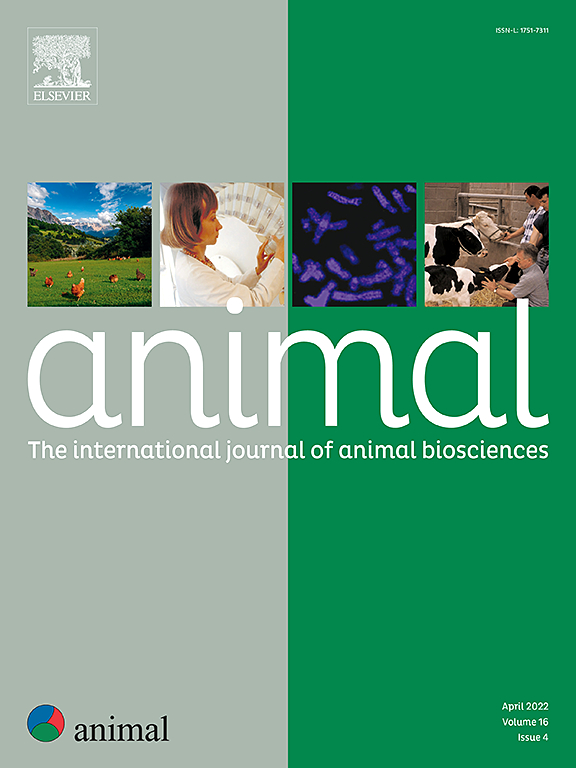有角的奶牛在松散的牛舍里比没有角的奶牛压力更大吗?有机奶牛场的横断面研究。
IF 4
2区 农林科学
Q1 AGRICULTURE, DAIRY & ANIMAL SCIENCE
引用次数: 0
摘要
在商业化的奶牛养殖中,大多数奶牛都是去角或遗传上无角的。有人认为,这减少了有害的和紧张的社会冲突的风险。另一方面,在有角的牛群中,管理和住房可能会更好地适应奶牛,例如,通过避免牛群结构的变化或提供更多的空间和资源,这将有助于减轻压力。本横断面研究选取了12头有角和13头无角的松散圈养有机奶牛,旨在探讨牛角状态对粪便皮质醇代谢物(fcm)的影响,fcm是奶牛应激水平的一个指标,同时考虑到农场在遵守管理和减少社会冲突的圈养建议方面可能存在的差异。收集674头奶牛(n = 2 625份)的重复粪便样本,采用酶免疫分析法分析fcm。总共记录了22个与指南建议相关的住房和管理因素。每个因素被归类为合规、部分合规或不合规,并计算住房、管理和总体合规的百分比。各个农场的总体依从性差异很大,从20%到93%不等。住房和管理依从性正相关(rs = 0.62),有角牛的农场遵守了更多的建议(中位数:60% vs 48%)。计算了一个线性混合模型,该模型具有喇叭状态、整体柔度及其相互作用的固定效应。随机效应将奶牛嵌套在牛群中,协变量包括奶牛的产奶天数和采样时间。有角兽群的FCM水平并不高于无角兽群。然而,与预期相反,没有发现与依从性有关。需要更多的知识来了解FCM水平在多大程度上反映了社会压力,以及个人住房或管理因素在减轻压力方面是否特别重要。本文章由计算机程序翻译,如有差异,请以英文原文为准。
Are horned cows in loose housing more stressed than hornless cows? a cross-sectional study in organic dairy farms
In commercial dairy farming, the majority of cows are dehorned or genetically hornless. It is argued that this reduces the risk of injurious and stressful social conflicts. On the other hand, in horned herds, management and housing may be better adapted to the cows, e.g. by avoiding changes in herd structure or by providing more space and resources, which would contribute to reducing stress. This cross-sectional study with 12 horned and 13 hornless organic dairy herds in loose housing aimed to explore the effect of horn status on faecal cortisol metabolites (FCMs) as an indicator for the cows’ stress level while taking into account possible differences in the farms’ compliance with management and housing recommendations for reducing social conflicts. Repeated faecal samples were collected from 674 cows (n = 2 625 samples), and FCMs were analysed by enzyme immunoassay. A total of 22 housing and management factors relating to guideline recommendations were recorded. Each factor was categorised as compliant, partly compliant, or non-compliant, and percentages of housing, management, and overall compliance were calculated. There was a wide variation in overall compliance between farms, ranging from 20 to 93%. Housing and management compliance correlated positively (rs = 0.62) and farms with horned cows complied with more recommendations (median: 60 vs 48%). A linear mixed model was calculated with the fixed effects of horn status, overall compliance, and their interaction. Cow was nested within herd as a random effect, and days in milk and time of sampling were included as covariates. FCM levels were not higher in horned compared to hornless herds. However, contrary to expectations, no associations with compliance were found. More knowledge is needed about the extent to which FCM levels reflect social stress and whether individual housing or management factors may be particularly important in reducing stress.
求助全文
通过发布文献求助,成功后即可免费获取论文全文。
去求助
来源期刊

Animal
农林科学-奶制品与动物科学
CiteScore
7.50
自引率
2.80%
发文量
246
审稿时长
3 months
期刊介绍:
Editorial board
animal attracts the best research in animal biology and animal systems from across the spectrum of the agricultural, biomedical, and environmental sciences. It is the central element in an exciting collaboration between the British Society of Animal Science (BSAS), Institut National de la Recherche Agronomique (INRA) and the European Federation of Animal Science (EAAP) and represents a merging of three scientific journals: Animal Science; Animal Research; Reproduction, Nutrition, Development. animal publishes original cutting-edge research, ''hot'' topics and horizon-scanning reviews on animal-related aspects of the life sciences at the molecular, cellular, organ, whole animal and production system levels. The main subject areas include: breeding and genetics; nutrition; physiology and functional biology of systems; behaviour, health and welfare; farming systems, environmental impact and climate change; product quality, human health and well-being. Animal models and papers dealing with the integration of research between these topics and their impact on the environment and people are particularly welcome.
 求助内容:
求助内容: 应助结果提醒方式:
应助结果提醒方式:


